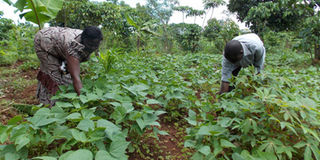Zinc, iron fortified beans in the offing

Farmers in their farm. Out of the Shs29 trillion budget, Shs17.4 trillion will cater for recurrent expenditure, Shs11.5 trillion for service development expenditure, a chunk of which will be for infrastructure under the Uganda National Roads Authority. FILE PHOTO
What you need to know:
On top of being able to give good yields to farmers, beans should enhance nutrition for consumers.
As pests and diseases continue to ravage different crops, breeding of new varieties to overcome this challenge and also enhance their nutritional value. Though beans, both the bush and climbing varieties, are a source of proteins, they can be boosted by incorporating vitamins, iron and zinc.
Researchers at National Crops Resources Research Institute (NaCRRI) are developing 12 bean varieties with iron and zinc content to add to the protein. The team is led by Dr Michael Ugen, who heads NaCRRI’s legumes programme. The team is using both conventional and biotechnology means in the research.
Driving force
When working on new varieties, the scientists take into consideration preferences of the farmers and consumers.
Then, a survey is carried out in various districts to find out which varieties are grown most.
Farmers in lowlands like in eastern and northern Uganda prefer bush beans while those in highlands especially in the western region prefer climbing beans.
This, therefore, acts as a driving force for scientists to suit interests of the farmers.
Bean varieties acquired from Colombia are being cross-pollinated with local varieties through cross pollination to come up with varieties that are liked by farmers as well as consumers.
The varieties, being developed, contain 40 to 50 milligrammes of iron and 75 to 120 milligrammes of zinc. While iron and zinc are required in small quantities in the human body, there are macro-nutrients such as potassium, which are needed in larger quantities to manufacture protein for human consumption.
Desired characteristics
In explaining the research, Dr Ugen said the work began four years ago. It is now in advanced stages, and there is a possibility of releasing four varieties by next year. There are both bush and climbing bean varieties, which are being tested in different locations around the country to establish acceptability by farmers, postharvest handling as well as to ascertain characteristics of the beans when cooked.
During breeding, the scientists are testing for iron and zinc content, improving size of the seed, the colour as well as taste. They are also bred to counter the pest and disease challenge.
This includes root rot, which attacks the roots at earlier stages, two to three weeks after planting, and causes them to eventually wither. There is Anthranose that attacks the leaves of the plant, and bean stem maggot that infests the stems and makes the leaves become yellowish and eventually wilt. Some of the viral infections include bacterial blight.
Aphids are some of the pests. They leave blacks spots on the leaves and destroying the entire plant. Others are pod borers and beetles such as the bean weevil.
In 2012 and 2013, seven bush bean-- Nabe17 to 27--and four climbing bean varieties--Nabe26c to 29c--were released to address the pest and disease burden, period of maturity and issues of climate change. Also, Dr Ugen adds, from 1994 to 2010, 18 bean varieties were released but due to factors such as changes in climatic conditions, a number of them have succumbed to diseases.
Research work on the bean crop is going on in various countries in East Africa. Sometimes, the scientists involved share materials and ideas because farmers across the region have similar interests.
Regional effort
In Kenya, University of Nairobi is conducting on varieties that thrive during drought as well as those have nutrients such as iron and zinc. The other characteristics being explored are capability to grow where the soil fertility is low and the level at which the plant absorbs water.
In addition, farmers are always encouraged to observe agronomic practices such as recommended spacing, weeding, spraying and fertiliser application for good yields in terms of quality and quantity.




